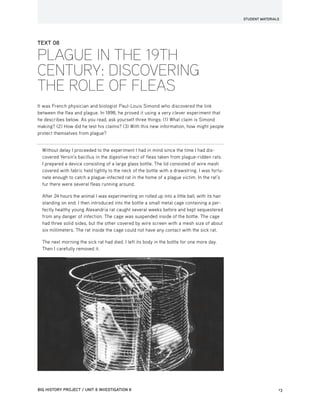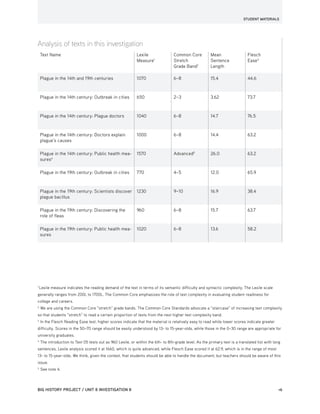The document outlines a two-part educational investigation focused on how and why collective responses to disease, specifically the bubonic plague, have changed from the fourteenth to the nineteenth centuries. Students are tasked with exploring and analyzing texts in the first part and then writing a five- to six-paragraph essay based on their findings in the second part, utilizing historical context and critical thinking. This investigation aims to deepen students' understanding of historical changes and their connection to broader themes in big history.

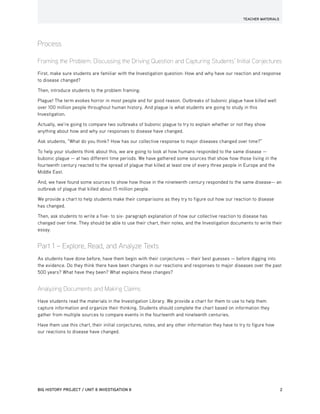
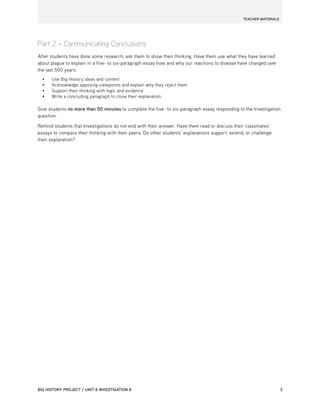






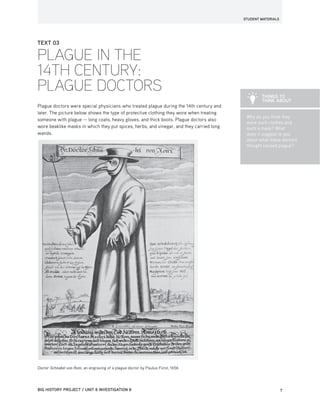
![STUDENT MATERIALS
BIG HISTORY PROJECT / UNIT 8 INVESTIGATION 8 8BIG HISTORY PROJECT / UNIT 8 INVESTIGATION 8
TEXT 04
PLAGUE IN THE
14TH CENTURY:
DOCTORS EXPLAIN THE
CAUSES OF PLAGUE
Physicians of the 14th century had many different explanations for what caused plague.
Here are three. As you read, ask yourself four questions: (1) What claims were these
doctors making about the disease? (2) What claim testers were they using? (3) If someone
believed this claim, then how might they prevent catching the plague? (4) Finally, what
do you think of the claim?
A Muslim doctor living in Spain, Lisan al-Din Ibn al-Khatib, wrote this explanation of
how plague spread between 1349 and 1352. His claim is that plague is contagious, that
is, healthy people get it from sick people.
Contagion has been proved by experience, deduction, the senses, and observation,
and unanimous reports to cause plague. It is not a secret: those who come into contact
with [plague] patients mostly die, while those who do not come into contact survive.
Moreover, disease occurs in a household or neighborhood because of the mere pres-
ence of a contagious dress or utensil. Even [a contaminated] earring has been known
to kill whoever wears it and his whole household. And when it happens in a city, it
starts in one house and then affects the visitors of the house, then the neighbors, the
relatives, and other visitors until it spreads throughout the city. Reports were unani-
mous that isolated places that have no roads to them and are not frequented by people
have escaped unscathed from the plague.](https://image.slidesharecdn.com/u8investigation2017teacher-171218185812/85/Unit-8-Investigation-8-11-320.jpg)
![STUDENT MATERIALS
BIG HISTORY PROJECT / UNIT 8 INVESTIGATION 8 9BIG HISTORY PROJECT / UNIT 8 INVESTIGATION 9
The king of France asked the doctors at the Paris medical school to explain what was
causing plague. They claimed that constellations had created vapors that polluted the air.
We, the Members of the College of Physicians of Paris, intend to make known the
causes of this pestilence. We, therefore, declare as follows: It is known that in India
the constellations exerted their power against the sea and the waters of the ocean
arose in the form of vapor. Thereby the waters were so corrupted that the fish which
they contained died. This vapor spread itself through the air in many places on Earth.
On all the islands and adjoining countries to which the corrupted sea-wind extends,
if the inhabitants of those parts do not take the following advice, we announce to them
inevitable death.
Every one of you should protect himself [and herself] from the air. Wormwood and
chamomile should be burnt in great quantity in the market places and in the houses.
Going out at night is dangerous on account of the dew. Rainwater must not be
employed in cooking, and everyone should guard against exposure to wet weather,
fasting and anxiety of mind, anger, and immoderate drinking. Bathing is injurious.
Some people thought that evil people had caused the plague. In fact, many minorities,
including Jews, were persecuted unjustly because people blamed them for the
plague. Here a physician, Alphanso of Cordoba, explains how someone could spread
plague to an entire city and not catch it himself.
Air can be infected artificially and placed in a glass bottle. When this preparation is
well fermented, whoever wishes to produce this evil will wait for a strong and
steady wind. Then he will walk against the wind opposite the city or town he wishes
to infect. Going back against the wind, so as not to be infected by the vapor, he will
throw the glass bottle [with the disease in it] with against the stones. As soon as the
bottle is broken the [disease] vapor will spread out and disperse in the air. Whoever
is touched by this vapor will die very soon.
Sources
Modified from John Aberth, The First Horseman: Disease in Human History (Upper Saddle River, NJ:
Pearson Prentice Hall, 2007) 44–45.
Modified from George Deaux, The Black Death: 1347 (New York: Weybright and Talley, 1969), 52–53.
Modified from Jon Arrizabalaga, “Facing the Black Death: Perceptions and Reactions of University
Medical Practitioners,” in Luis García-Ballester, Roger French, Jon Arrizabalaga, and Andrew
Cunningham (ed.) Practical Medicine from Salerno to the Black Death (New York: Cambridge University
Press, 1993), 257.](https://image.slidesharecdn.com/u8investigation2017teacher-171218185812/85/Unit-8-Investigation-8-12-320.jpg)


![STUDENT MATERIALS
BIG HISTORY PROJECT / UNIT 8 INVESTIGATION 8 12BIG HISTORY PROJECT / UNIT 8 INVESTIGATION 12
TEXT 07
PLAGUE IN THE 19TH
CENTURY: SCIENTISTS
DISCOVER THE
PLAGUE BACILLUS
Medical science made a dramatic leap forward in the modern era with the discovery of
bacteria and the link between some of the microorganisms and disease. Using micro-
scopes and working in labs, 19th-century researchers such as Louis Pasteur and Robert
Koch connected bacteria to such diseases as tuberculosis, diphtheria, tetanus, and plague.
People worldwide read about such discoveries in new scientific journals or learned
about them at scientific conferences. Sometimes scientists or nations competed with
each other to make an important contribution to our collective learning. Such is the story
of the discovery of the bacteria that causes plague.
When the news spread of plague’s outbreak in Hong Kong in 1884, there was immedi-
ate interest from scientists’ eager to find a cause, a cure, and possibly fame for
themselves and their countries. In June 1884, two researchers — Shibasaburo Kitasato
from Japan and Alexandre Yersin from Switzerland — using microscopes to study the
blood from infected rats and people almost simultaneously identified the bacteria that
caused plague. For years there was a great rivalry over whether Kitasato or Yersin
was first and more accurate in identifying the plague bacillus, or the bacteria that
caused plague. Eventually, scientists found that Yersin was more accurate and today
that bacteria is called Yersina pestis.
Not only did Yersin identify the bacteria, he made the connection – a mistaken connection,
by the way — between rats and plague. He wrote in a journal shortly after his discovery:
I have placed healthy mice and inoculated [diseased] mice in the same cage. The
inoculated ones died first, but within a few days all of the others die from the invasive
plague bacillus. Plague is therefore a contagious and transmissible disease. It is
probable that rats are the major vector [carrier of the disease].
Yersin was wrong about rats spreading the infection. The next text will explain how
another scientist corrected Yersin’s mistake.
Sources
Myron Echenberg, Plague Ports: The Global Urban Impact of Bubonic Plague Between 1894 and 1901
(New York: New York University Press, 2007) 6.
Roy Porter, The Greatest Benefit to Mankind: A Medical History of Humanity (New York: Norton, 1997)
443–44.](https://image.slidesharecdn.com/u8investigation2017teacher-171218185812/85/Unit-8-Investigation-8-15-320.jpg)
